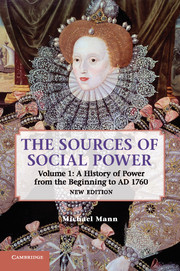Book contents
- Frontmatter
- Contents
- Preface to the new edition
- Preface
- 1 Societies as organized power networks
- 2 The end of general social evolution: how prehistoric peoples evaded power
- 3 The emergence of stratification, states, and multi-power-actor civilization in Mesopotamia
- 4 A comparative analysis of the emergence of stratification, states, and multi-power-actor civilizations
- 5 The first empires of domination: the dialectics of compulsory cooperation
- 6 “Indo-Europeans” and iron: expanding, diversified power networks
- 7 Phoenicians and Greeks: decentralized multi-power-actor civilizations
- 8 Revitalized empires of domination: Assyria and Persia
- 9 The Roman territorial empire
- 10 Ideology transcendent: the Christian ecumene
- 11 A comparative excursus into the world religions: Confucianism, Islam, and (especially) Hindu caste
- 12 The European dynamic: I. The intensive phase, a.d. 800–1155
- 13 The European dynamic: II. The rise of coordinating states, 1155–1477
- 14 The European dynamic: III. International capitalism and organic national states, 1477–1760
- 15 European conclusions: explaining European dynamism – capitalism, Christendom, and states
- 16 Patterns of world-historical development in agrarian societies
- Index
- References
3 - The emergence of stratification, states, and multi-power-actor civilization in Mesopotamia
Published online by Cambridge University Press: 05 July 2013
- Frontmatter
- Contents
- Preface to the new edition
- Preface
- 1 Societies as organized power networks
- 2 The end of general social evolution: how prehistoric peoples evaded power
- 3 The emergence of stratification, states, and multi-power-actor civilization in Mesopotamia
- 4 A comparative analysis of the emergence of stratification, states, and multi-power-actor civilizations
- 5 The first empires of domination: the dialectics of compulsory cooperation
- 6 “Indo-Europeans” and iron: expanding, diversified power networks
- 7 Phoenicians and Greeks: decentralized multi-power-actor civilizations
- 8 Revitalized empires of domination: Assyria and Persia
- 9 The Roman territorial empire
- 10 Ideology transcendent: the Christian ecumene
- 11 A comparative excursus into the world religions: Confucianism, Islam, and (especially) Hindu caste
- 12 The European dynamic: I. The intensive phase, a.d. 800–1155
- 13 The European dynamic: II. The rise of coordinating states, 1155–1477
- 14 The European dynamic: III. International capitalism and organic national states, 1477–1760
- 15 European conclusions: explaining European dynamism – capitalism, Christendom, and states
- 16 Patterns of world-historical development in agrarian societies
- Index
- References
Summary
Introduction: civilization and alluvial agriculture
The argument of the last chapter was somewhat negative: The emergence of civilization was not an outgrowth of the general properties of prehistoric societies. This appears to be immediately supported by the fact that it happened independently only a few times – probably on six occasions, perhaps as rarely as three or as frequently as ten. Yet it has long been believed that there was something of a common pattern among these cases, centering on the presence of alluvial agriculture. So was the emergence of civilization, together with its concomitant features of social stratification and the state, more than a historical accident? Even if the cases were few, were they patterned? I will argue that they were. Identifying the pattern, and its limitations, is the purpose of this chapter and the next.
We can never exactly define what we mean by “civilization.” The word has too much resonance, and the prehistoric and historic record is too varied. If we focus on a single supposed characteristic of civilization, we get into difficulties. Writing, for example, is characteristic of peoples we intuitively regard as civilized. It is a perfect indicator of “history” rather than “prehistory.” But it is also found, in rudimentary form, in prehistoric southeastern Europe, unaccompanied by the other usual appurtenances of civilization. The Incas of Peru, generally thought of as “civilized,” did not have writing. Urbanization, also general to “civilization,” does not give us a perfect indicator.
- Type
- Chapter
- Information
- The Sources of Social Power , pp. 73 - 104Publisher: Cambridge University PressPrint publication year: 2012



